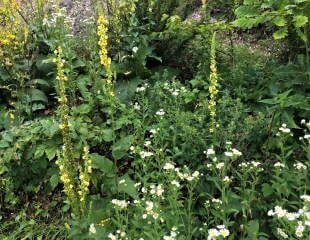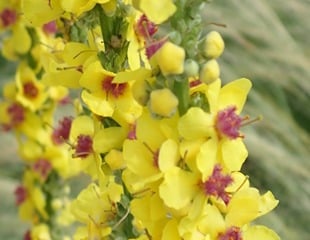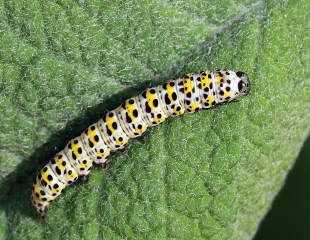


How to Grow Verbascum
Verbascum is a group of mainly summer flowering short-lived perennials and biennials. Spikes of flowers emerge from a basal rosette in a range of colours, white, yellow, various pinks and lavender, many with a contrasting eye. Flower height varies from 20cms to 2m.
Verbascum, although short-lived, is a tough, drought-tolerant plant which grows well in sun and on thin poor soil. They are ideal to plant in a dry corner of the garden and mix well with grasses suited to similar conditions. Originating from Turkey and dry areas of Europe, Verbascum will tolerate most conditions apart from winter wet, which can cause the plant to be very short-lived.
Plant in a sunny spot, in well-drained soil. Dead heading the flower spikes may result in a further flush of flowers.
Verbascum is ideal to naturalise in a semi wild setting where they will self seed and require little attention, see above left.
Verbascum is an eye-catching garden plant and, hopefully, these images illustrate this.
Ideas for the best Verbascum to grow
There is a baffling array of Verbascum offered for sale, particularly as recent years have seen an expansion of horticultural interest introducing many new cultivars. Some of the newer varieties are less short-lived and with a greater range of colours. Given the extensive range, picking those with known good qualities and/or the RHS Award of Garden Merit is always a good starting point.
Recommended is Verbascum chaixii var. album which is one of the most commonly grown varieties. Pure white flowers with pink eyes, it grows to around 90cms and has the RHS award.
Another popular variety illustrated centre top is Verbascum nigrum, a vigorous perennial variety, widely grown and reaching up to 1.2m
The native wild Verbascum Thapsus has multiple yellow flowers. This is a very tall biennial variety reaching a height in its second year of up to 2.5m, so not suitable for all gardens.
Often offered for sale are varieties in the Verbascum "Cotswold Group", a perennial variety growing to around 1m in a variety of colours besides the more common white and yellow, there are also buff, apricot, pinks and peachy shades.

A common predator of Verbascum
Another name for Verbascum is Mullein, and here we have the mullein moth. As the name suggests, this caterpillar is very fond of Verbascum, where it lays its eggs and feeds on the leaves.
This can cause significant damage to the leaves. In some ways, it's both the good and bad news. The bad news is all the damage the mullein moth can cause to Verbascum, but on the other hand, you are growing food, which is essential for the moth's life cycle. In common with other caterpillars they can be picked off by hand. Although the caterpillar can lacerate the Verbascum leaves, the plants usually recover.

Verbascum planting combinations
Verbascum looks good in a natural planting scheme and combined with grasses.
On the left an image taken at Kelmarsh Gardens planted with Stipa tenuissima.
Illustrated right, a drought tolerant combination of yellow Verbascum, annual blue cornflowers and various grasses including stipa tenuissima. This combination would be ideal in a dry part of the garden or, as seen here, spilling over into a path.

